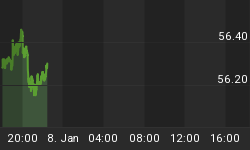Two economic reports released last week, the November ISM non-manufacturing survey and the November employment report, were interpreted by some that the overall economy was doing just fine and that there was no need for the Fed to consider cutting the funds rate. I respectfully disagree. Growth in the goods-producing sectors of the economy - manufacturing, mining and construction -- has weakened significantly. And it is in the goods producing sectors where the action always shows up first at cyclical turning points.
Some might respond that I'm living in the past. Don't the goods-producing sectors account for a much smaller share of real GDP than they used to? Actually, no. As shown in Chart 1, the combined output of goods and construction activity in 2005 represented 44.6% of real GDP. (I picked up this nugget of information from Joe Carson of Alliance Bernstein via a Bloomberg News column by Caroline Baum.) This is above both the average and median percentages of 43.3% and 43.4%, respectively, for the period 1950 through 2005. Back in 1999, the goods-producing sectors also accounted for 44.6% of real GDP. But you would then have to go all the way back to 1965 to find a percentage this high. So, although the service-providing industries combined make the largest contribution to real GDP, this is as it has been for the past 55 years. Moreover, the goods-producing sectors are now making a comeback.
Chart 1
Goods Producing Sectors* as % of Real GDP
1950 - 2005* goods plus construction
In terms of cyclicality, it is variability that matters, not size. Just eyeballing Chart 2 you can see that the year-to-year variation in the goods-producing sectors is larger than in the service-providing industries. But in case your eyesight is failing you, the standard deviation, a statistical measure of variability, of the year-to-year percent change in real goods-producing output was 3.8 from 1955 through 2005 vs. only 1.2 for service-providing output. Also notice that from 1955 through 2005 there has never been a year in which the change in the output of services was negative on an annual basis. Again, it is in the goods-producing sectors of the economy where the cyclical action is.
Chart 2
Growth in the goods-producing sectors has slowed significantly. Chart 3 shows that the quarter-to-quarter annualized growth in combined real output of goods and structures slowed to 1.7% in the third quarter, the slowest growth since the fourth quarter 2002. Notice that in the second half of 2000, the goods-producing sectors gave up the ghost but the service-providing sectors kept chugging along. The recession in 2001 was heralded by the weakness in the goods-producing sectors, not the service-providing sectors.
Chart 3
In its November survey, the Institute for Supply Management (ISM) reported that its index for manufacturing new orders fell to 48.7, the first time the index had visited sub-50 territory since April 2003 (see Chart 4). In contrast, the ISM index for non-manufacturing new orders increased in November, remaining well above the 50 level. Again, notice that back in 2000, the ISM manufacturing new orders index was diving below 50, but the non-manufacturing index did not dip below 50 until the 2001 recession had begun. I remember back in 2000, when the ISM manufacturing surveys were sending out a cyclical warning signal, the conventional wisdom was that the ISM manufacturing survey was "old economy" information, no longer relevant to the "new economy" we now had entered. The cyclical warning signal being sent by the negative spread between the yield on the Treasury 10-year security and the fed funds rate also was brushed off with the five most dangerous words in economic forecasting: "It is different this time."
Chart 4
This brings us to the November employment report. Payrolls in service-providing industries increased 172,000 whereas payrolls in goods-producing industries fell 40,000. November marked the third consecutive month in which payrolls in the goods-producing industries fell and the fourth decline in the past five months. Year-to-date in 2006, employment in the goods producing industries is up 38,000. This is much smaller than the 271,000 increase in the first 11 months of 2005. In contrast, in service-providing industries, employment is up 1.607 million year-to-date in 2006 vs. 1.588 million in the first 11 months of 2005. Does this stronger employment performance in the service-providing industries indicate that there is no reason to be concerned about a significant cyclical slowing in economic growth? An examination of Chart 5 would suggest that the sharp slowdown in employment growth in the goods-producing industries, 0.12% year-over-year in November, vs. the steady year-over-year employment growth of 1.56% in the service-providing industries is nothing to be sanguine about. As illustrated in the chart, there is greater cyclical employment variation in the goods- producing industries and employment in these industries tends to weaken sharply just before recessions. In contrast, employment growth in the service-providing industries tends to hold up reasonably well until the recession occurs.
Chart 5
In sum, in trying to divine the cyclical course of the economy, don't ignore the behavior of the goods-producing sector - a sector whose output accounts for 45% of real GDP and the sector that historically has exhibited the most cyclical variability.
*Paul Kasriel is the recipient of the 2006 Lawrence R. Klein Award for Blue Chip Forecasting Accuracy
















